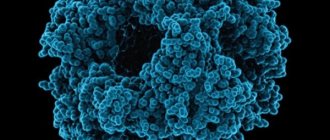Causes of vomiting during pregnancy
When does vomiting start during pregnancy? The placenta appears only in the ninth week after conception, and completes its formation closer to the sixteenth. All this time, the woman’s body is under the strong influence of toxins, which leads to vomiting and nausea during pregnancy. Toxicosis translated from Greek means “poisonous”.
With the onset of this condition, a woman experiences:
- vomiting in early pregnancy;
- loss of appetite;
- weakness;
- increased salivation;
- change in taste preferences;
- irritability, tearfulness.
Toxicosis is conventionally divided into three degrees of severity:
- Vomiting during early pregnancy, which does not occur more than 5 times a day. The general condition remains satisfactory. There is a slight weight loss.
- The frequency of vomiting attacks in pregnant women increases up to 10 times a day. Women feel worse: heart rate increases, blood pressure decreases (hypotension), weakness and dizziness develop. Weight loss up to 3 kg. Second degree toxicosis requires constant medical supervision.
- Severe vomiting during pregnancy - up to 25 times a day, which leads to fluid loss and electrolyte imbalance. The expectant mother is rapidly losing weight. Body temperature rises and bad breath appears. This condition requires hospital treatment.
The appearance of vomiting in late pregnancy is called gestosis or late toxicosis. This pathology requires immediate hospitalization, because even in developed countries, gestosis is a common cause of maternal mortality.
The main signs of late toxicosis:
- hypertension (high blood pressure);
- vomiting in the third trimester of pregnancy;
- dropsy or swelling;
- the appearance of protein in the urine;
- headache.
With severe attacks of nausea and vomiting in late pregnancy , as well as with other signs of gestosis, a woman should seek medical help.
Drug treatment for vomiting
Most expectant mothers strive to avoid taking medications while pregnant, but changes in diet and lifestyle are not always effective. In simple cases, vomiting can be stopped by washing the stomach with 2 liters of warm water. Next, after 10-15 minutes, the woman should drink mineral water or an infusion of chamomile or rosehip in tiny sips. If a pregnant woman is sure that her vomiting is caused by poisoning, then after gastric lavage it is necessary to take activated charcoal, based on the scheme: 1 tablet for every 10 kg of the woman’s weight.
But when the number of vomiting attacks exceeds 10 times a day, the pregnant woman’s body is dehydrated, and there is a decrease in its weight by more than 5% of the woman’s weight before pregnancy, then in such circumstances there is reason to suspect a severe degree of toxicosis (hyperemesis gravidarum). In such situations, doctors are forced to resort to drug treatment, which is primarily aimed at restoring the water balance in the body of the expectant mother. But often medications are also prescribed to prevent vomiting attacks.
The support of relatives and the absence of negative emotions are extremely important for a pregnant woman.
In addition to medications, in this case it is a good idea to influence acupuncture centers through massage. Taking vitamin B6 will also help. In addition, a woman should not worry prematurely about the feeling of bitterness in her mouth after vomiting. This is a fairly common phenomenon when carrying a baby, as the female body tries to adapt to a new state for it. Using the above techniques will help overcome this problem; they will not harm either the unborn child or his mother.
Types of pathology
In rare cases, the gag reflex is a symptom of a serious illness and requires specialist consultation.
To make an accurate diagnosis, you need to know which vomiting during pregnancy indicates pathological changes in the body:
- Morning sickness is not uncommon for many women who are expecting a baby, but vomiting during pregnancy in the evening is typical for diseases of the gastrointestinal tract.
- Vomiting during pregnancy, accompanied by fever. This occurs in acute intestinal infections and pathologies of internal organs, as well as in diseases of the genitourinary system.
- Diarrhea and vomiting during pregnancy occur due to food poisoning or infectious intestinal diseases.
- Vomiting of bile during pregnancy usually occurs in the morning, on an empty stomach. If this condition worsens after eating, this may indicate inflammation in the gallbladder (cholecystitis) or pancreas (pancreatitis).
- Vomiting blood during pregnancy indicates the manifestation or exacerbation of a gastric ulcer, as well as varicose veins of the esophagus. Also, with repeated vomiting, there is a risk of microcracks in the mucous membranes of these organs, which also contributes to the appearance of blood in the vomit.
- Acid vomiting during pregnancy occurs due to increased acidity in the stomach. A pregnant woman should carefully monitor the functioning of the gastrointestinal tract and control the acid that is released from the body.
- Green vomit during pregnancy often occurs as a result of repeated vomiting, the amount of bile rapidly increases, and the color of the vomit takes on a green tint. This color can also be caused by infectious diseases and mushroom poisoning.
What does vomiting in the first and second trimester indicate?
During pregnancy, the body undergoes significant restructuring and changes. Hormonal levels are of primary importance. Under its influence, a woman becomes emotionally unstable, excitable, sensitive, vulnerable, and susceptible to stressful risk provocateurs. Against the background of anxiety, irritation and spasms of the stomach muscles may occur, during which bile from the duodenum is sucked in. The gallbladder spasms and bile refluxes into the stomach.
Vomiting with bile is typical only on an empty stomach in the first and second trimesters of pregnancy. The appearance of bile in rejected food indicates the presence of diseases in the patient.
Early toxicosis
Toxicosis in the early stages of pregnancy, starting from the 5th week, may be accompanied by mild morning sickness, provided that the stomach is empty. Peristaltic waves of the stomach walls create negative pressure, and a kind of pump-type absorption of bile occurs. The woman feels bitterness, an unpleasant odor in the mouth, and yellow or greenish inclusions in the vomit are visually noticeable.
Early toxicosis is a mechanism of adaptation of a woman’s body to bearing a fetus. The condition gradually goes away and does not require medication support.
Vomiting is acceptable in the morning and afternoon, up to five times. If this indicator is increased, then the risk of dehydration increases significantly. The addition of any discomfort or impurities in the vomit, in addition to bile, requires special treatment under the supervision of a doctor.
Poisoning
It is important to distinguish between the phenomena of toxicosis in pregnant women and poisoning in the early stages. When eating exotic foods, fried, spicy, or changing eating habits, it is worth noting the connection of the gag reflex with food intake. When the body is intoxicated, vomiting is repeated, with strong spasms and acquires a gray tint (gray mucus indicates the presence of chemical poisons).
Vomiting with bile can be caused by parasitic organisms - waste from helminthic infestations provokes nausea and intoxication of the body. Worms can migrate into the gallbladder and irritate its walls.
Diseases
With concomitant diseases of internal organs, especially the gastrointestinal tract, a gag reflex may occur with an exacerbation of chronic pathological processes. Among the common ones are:
- Inflammatory processes in the pancreas due to improper nutrition of the expectant mother (tendency to salty, fried foods). There is a process of development of pancreatitis with an exacerbation of the chronic process against the background of overeating, decreased physical activity, diseases of the hepatobiliary system, and lack of protein components in the daily diet. Distinctive signs of non-pathological vomiting of bile from pancreatitis: morning sickness appears, the nature of the stool changes. Feces become discolored, have greasy spots, and acquire a foul odor. Among the symptoms, it is worth noting a sharp pain in the left side.
- Liver dysfunction or development of viral hepatitis. With increased load on the liver and changes in metabolic processes, a gag reflex is provoked, mainly after eating fatty foods. A distinctive feature is the yellowness of the skin (in severe cases - icterus of the eye whites, mucous membranes of the eyelids), discoloration of the stool, dark color of the urine. Contraindications to the independent use of any medications are strict, since they can harm the mother’s body and the fetus.
- With cholecystitis, there is stagnation of the contents of the gallbladder, changes in hormonal levels, and susceptibility to infectious processes provoke attacks of acute cholecystitis. Clinical picture: pain in the right side, heaviness in the stomach after eating, loose stools, bitterness in the mouth with symptoms of heartburn. Vomiting occurs throughout the day, only after eating. Anomalies in the structure of the gallbladder with the development of bends, kinks, and a pear-shaped shape provoke a process with bile. The process of bile evacuation is disrupted, the walls of the gallbladder are overstretched with periodic spasms. The change in shape can occur under the influence of compression of the growing uterus and disappear spontaneously after childbirth.
- Vomiting with reflux gastritis due to pathology of the sphincter, which blocks the lumen of the stomach and duodenum. There is a constant reflux of small portions of bile, irritation of the stomach walls with provocation of food rejection.
- Vomiting in ulcerative pathologies of the gastrointestinal tract is distinguished by an admixture of brown or bright scarlet color - streaks of blood from bleeding ulcers in the gastric juice or a consequence of rupture of the mucous membranes near the ulcerative lesions. You should not stop this condition on your own; you must urgently call a doctor.
Other reasons
May occur due to pressure of the uterus on the mother's diaphragm in the third trimester of pregnancy. The mother's body reacts with heartburn, morning sickness and vomiting.
Loading …
First aid consists of several stages:
- Gastric lavage. The patient drinks about two liters of clean drinking water on her own. The liquid fills the stomach, which provokes an attack of vomiting or it can be artificially induced. Water prevents the development of dehydration; the procedure for washing the digestive tract will be as safe as possible.
- It is necessary to drink water, rosehip decoction, uzvar, still mineral waters or herbal teas in small sips throughout the day.
- Take a sorbent (activated carbon, lactofiltrum, white coal) to eliminate intoxication and remove metabolic breakdown products from the bloodstream.
- If nausea occurs from certain smells, try to move away from them, open the window wide. Use a hood when preparing food.
- Try to relax more, spend time in the fresh air, which has a beneficial effect on the body of a pregnant woman.
- Immediately after waking up, it is recommended to eat a cracker, a piece of bread, cookies and lie down after 15-20 minutes (excessive activity negatively affects the digestion processes). Not staying hungry for a long time – this provokes the condition. Eat small meals often throughout the day.
When does vomiting during pregnancy become dangerous?
During pregnancy, vomiting in women is normal and goes away on its own after the body has completely adjusted to its new state. But there are cases when, in combination with other symptoms, vomiting during pregnancy is pathological and requires emergency medical attention.
You should consult a doctor if:
- During pregnancy, a woman experiences nausea without vomiting in combination with increased blood pressure;
- there is repeated vomiting in the second trimester of pregnancy;
- gagging is accompanied by an increase in body temperature or disruption of the digestive system;
- there is blood in the vomit;
- vomiting during pregnancy is yellow or has a green tint;
- significant weight loss occurs;
- there are signs of intoxication and dehydration;
- there is swelling.
When should you start worrying?
According to statistics, only up to 15% of pregnant women require treatment for symptoms and manifestations of nausea. They exhibit a medium and severe stage of vomiting, which manifests itself in the fact that the woman carrying the baby rapidly loses all the substances and resources accumulated in the body. A young mother may experience a stage of intoxication and dehydration , which negatively affects her health and the unborn child.
Reading...
Why can your hands go numb during pregnancy?
You need to make an appointment with a doctor if:
- Vomiting occurs a large number of times per day, more than six;
- There is rapid weight loss;
- The amount and color of urine decreases;
- Dry mouth appears;
- Movements are inhibited and mental activity decreases;
- Heart rate increases;
- Fainting occurs or a pre-fainting state occurs during daylight hours.
In this case, the attending doctor may recommend hospital stay. A woman’s condition during pregnancy can be alleviated by intravenously administered medications that can stop the process of intoxication of the body and compensate for the imbalance of the necessary fluid.
If the medications prescribed by the doctor do not give positive results and the pregnant woman’s condition worsens, the doctor may decide to interrupt the pregnancy process. But such measures are drastic and are taken extremely rarely.
Also, to alleviate the current situation, you can ask for vacation or sick leave at work so that the body can begin its recovery. Toxicosis in most cases tends to end after 12-14 weeks of pregnancy .
- Related Posts
- The navel (and near it) hurts during pregnancy
- What are the reasons for chest pain during pregnancy?
- Why can a pregnant woman's right side hurt?
How to alleviate the condition?
What to do if you experience vomiting during pregnancy? Toxicosis causes severe discomfort for pregnant women. To help your body cope with the feeling of nausea, you can eat a green apple or take a few sips of mineral water in the morning, without getting out of bed.
Expectant mothers often wonder whether pregnant women can induce vomiting to relieve their condition in case of nausea. No, you shouldn’t do this; every effort should be made to minimize the occurrence of vomiting in pregnant women.
To make it easier, just follow simple rules:
- exclude fatty, smoked, sweet foods from the diet, and also avoid drinking carbonated drinks and coffee;
- change your daily routine, relax more and be in the fresh air;
- drink teas with the addition of mint, lemon balm, ginger;
- eat food in fractional portions and avoid overeating.
Expectant mothers should be attentive to their health, because a woman’s body during this period is very vulnerable and sensitive to external irritants. It is necessary to notify the attending physician about all changes and symptoms in a timely manner to avoid negative consequences.
Author: Yulia Sivitskaya, doctor, especially for Mama66.ru
Preventive measures
Toxicosis cannot be prevented; unfortunately, it accompanies more than 60% of women. You can only alleviate the course of the disease by reducing the number of attacks. To do this, it is advisable for the expectant mother to give up fatty, spicy, salty, smoked and canned foods. In some cases, it helps to limit the amount of sweets, as well as all drinks except water (coffee, tea, compotes, lemonades). On the bedside table you need to put a glass of water and dry cookies, a banana or an orange. If you have this breakfast right away in the morning, without getting out of bed, you will feel less sick.
It is difficult to protect against exacerbation of chronic diseases. A pregnant woman can eat right, spend more time in the fresh air and visit the doctor regularly. Having noticed the first symptoms of pancreatitis, cholecystitis, or intestinal infection, you should urgently consult a doctor. The sooner the examination is completed, the lower the risk of complications.
Being a mom is a lifetime of hard work. From the moment of conception, a woman is responsible not only for herself, but also for the life of her baby. During his stay in the womb, she will have to experience toxicosis, which is often accompanied by vomiting with bile. As a rule, this is nothing serious, but consulting a specialist will not be superfluous.
You can ask your question to our author:
Why is bile thrown into the stomach?
Pathology is observed when:
- the development of pulp, which regulates the transport of food masses from the gastric cavity to the cavity of the duodenum;
- the presence of chronic inflammatory processes of the biliary tract or organs such as the gallbladder or liver;
- increased intra-abdominal pressure;
- developmental anomalies of the gastrointestinal tract;
- removal of the gallbladder or its congenital absence;
- disorders of the nervous regulation of the digestive system;
- food intoxication;
- the presence of acute intestinal infections caused by salmonella, typhoid bacteria, cholera pathogens, staphylococcus;
- poisoning with mushrooms or substances of chemical origin (dark green vomit is observed).
Attention! Green vomit in humans is quite often observed with the development of tumors of the gastrointestinal tract. The tumor is capable of compressing the digestive organs, which provokes the development of such a pathological process as reflux of bile masses - their reflux into the lumen of the stomach.
What symptoms does it accompany?
Vomiting of green bile is accompanied by:
- Preceded by nausea. The more intense it is, the greater the intoxication of the body. In cases of food poisoning, emptying the stomach of food masses alleviates the patient's condition. But in the presence of diseases of infectious origin, the presence of repeated vomiting only harms the patient.
- Diarrhea. In this case, fecal masses are able to acquire a specific color and change their consistency. This often makes it easier for the patient to diagnose.
Find out why a rash appears after poisoning: causes and treatment.
Read what to do if weakness appears after poisoning: treatment and recovery period.
It is worth knowing that green vomit in a child primarily indicates the presence of an infectious disease (see Salmonellosis in a child). After all, it is children, due to their physiological characteristics and frequent failure to comply with personal hygiene rules, who are most susceptible to infectious diseases and especially diseases of the digestive system.
Green vomit streaked with blood may indicate a pronounced inflammatory process not only in the organs of the biliary (biliary) system, but also in inflammation of the stomach. And if at the same time there is pain in the middle upper third of the abdomen, then the likelihood of such a diagnosis becomes even higher.
Vomiting of a yellow-green color indicates that an excessive amount of hydrochloric acid is synthesized in the stomach, which mixes with bile and gives a characteristic color. This is observed in cases of disturbances in the passage of bile masses and excessive secretory activity of the stomach.
Green vomiting can appear with a combination of bile outflow disorders and obstruction of food masses through the lower part of the stomach (observed in pathologies of the pyloric part of this organ).
What to do if a pregnant woman experiences green vomit?
Green vomit during pregnancy is a sign of toxicosis. This is a natural process that appears in the early stages of pregnancy, when there is discoordination between many physiological processes in a woman’s body.
However, if the urge to vomit and empty the stomach are observed too often, this indicates a pathological process. This condition is called vomiting gravidarum. Depending on how many times a woman vomits, the severity of the pathological condition varies (from mild to severe). In moderate to severe cases, urgent treatment in a hospital is required.
Important! If there are symptoms of toxicosis, a pregnant woman should seek professional advice from a gynecologist.
The connection between the color of bile in vomit and problems in the body
To make a correct diagnosis, it is important to correctly compare the symptoms. If a pregnant woman is constantly vomiting, it is important to know how and how long the nausea lasted, when the last meal was, and what was eaten. The color of the vomit also matters.
If you vomit green bile during pregnancy, the release of secretions into the stomach is most likely accidental and does not threaten your health. A greenish tint is natural for bile; at a minimum, it indicates the absence of abnormalities in the digestive system.
In addition, vomit can be colored:
- Yellow-green. The color indicates the presence of a large amount of bile and hydrochloric acid in the stomach. This indicates a violation of the proper outflow of liver secretions.
- Grey. The mucus gives a hint of bile. Its presence is evidence of poisoning by poisons or mushrooms.
- Yellow. The color indicates the consumption of low-quality or expired products.
- Brown. Indicates internal bleeding. Brown bile in vomit is typical for women with stomach ulcers, polyps or tumors in the stomach. Erosion on the walls of the organ bleeds.
- Red. The bleeding started in the esophagus.
- Dark green. Indicates the presence of a large amount of thick, stagnant bile mixed with blood.
Sometimes the cause of bilious vomiting during pregnancy is helminths. They clog the ducts of the biliary system and the bladder. Liver secretions stagnate in the organs, thickening. The color of the bile becomes dark.
An almost black secretion is evidence of advanced inflammatory processes in the body, possibly with partial tissue necrosis.
What to do if a person has green vomit?
In the event that green vomit also results in a rise in body temperature, profuse diarrhea, and pain in the abdominal area, you need to seek medical help. If the patient’s condition does not allow him to see a doctor on his own, you need to call an emergency medical team. Paramedics will decide on the spot whether the patient needs to be hospitalized in the infectious diseases department of the hospital. In cases where the help of emergency doctors is not needed, a therapist is called to your home.
Causes
In pregnant girls, an attack of nausea and vomiting with bile can be caused by poisoning, chronic diseases, or as a consequence of traumatic brain injuries. A girl's body in this position is more vulnerable to viruses and infections due to reduced immunity in pregnant women.
Women have toxicosis while carrying a child, which causes many problems, including vomiting. A woman can vomit in the first months of pregnancy, throughout the entire period. Often the reason for such a reaction in the body remains unknown.
Pancreatitis
The pathology often first appears during pregnancy. The reason is compression of the pancreas by the enlarged uterus. The disease is promoted by abuse of pickles and overeating. Lack of physical activity, taking medications, and the pathological influence of estrogens provoke inflammation of the stomach. Foul-smelling, foamy stools often accompany nausea and vomiting of bile.
In the first trimester, chronic pancreatitis provokes miscarriage. The third trimester of the disease is accompanied by late toxicosis, which is life-threatening for the patient and child. Exacerbation of the disease requires immediate hospitalization.
Early toxicosis
Approximately the fifth week is marked by the onset of toxicosis. Early toxicosis is a girl’s condition, accompanied by an illness in the form of nausea and vomiting, sometimes with bile. Vomiting is a common body reaction to pregnancy. Most often occurs in the morning. If the expectant mother is hungry, this can happen at any time of the day.
Nausea in the first trimester can occur from the smell of food, perfume, the taste of toothpaste, etc. Subsequently, the stomach begins to contract, drawing bile from the gallbladder. Then the bile comes out. You can avoid it by eating small amounts in the morning. Typically, in the second trimester, toxicosis tends to subside, and pregnancy proceeds well.
Inflammation of the appendix
Acute appendicitis is a rather rare occurrence in early pregnancy; the disease most often manifests itself in the third trimester. At the first stage of development of the disease, pain appears in the stomach, spreading to the right side of the abdomen. Everything is accompanied by nausea and vomiting with bile. The temperature rises, the pain becomes unbearable, and the patient’s condition worsens. Untimely assistance from a surgeon threatens a pregnant woman with placental abruption, infection of the fetus, disruption of intrauterine development, and termination of pregnancy.
How not to confuse pathological vomiting with toxicosis of pregnant women
In the early stages of pregnancy, vomits bile in the morning, when the remains of dinner have already been digested, and new food has not yet entered the stomach.
Cramps can occur during the day, but only under conditions of prolonged fasting. In the first trimester, the body perceives the fetus as a foreign body, directing all its forces to cleansing. This causes bouts of vomiting.
Toxicosis and vomiting of bile completely disappear by the 16th week of pregnancy. If spasms continue in the later stages, the doctor suspects that the woman has serious pathologies of the gastrointestinal tract.
In the absence of pathological processes during pregnancy, bilious vomiting is not accompanied by stool upset and occurs exclusively on an empty stomach.
Consequences
Vomiting, in addition to discomfort, causes a lot of other unpleasant consequences for any person. For a pregnant woman, it is dangerous because the fetus itself can suffer. Dehydration is the first and obligatory consequence of the body’s vomiting reaction. Severe vomiting, which prevents food from remaining in the body, sometimes triggers the process of tissue destruction from the inside due to lack of nutrients.
When vomiting bile during pregnancy, the acids irritate the stomach, which leads to inflammation, and subsequently the development of serious diseases. It is worth stopping the vomiting as soon as possible with the help of a doctor or on your own.
Diagnostics
If symptoms occur, you should notify your obstetrician-gynecologist. You may need to consult other doctors to help establish a diagnosis and prescribe the correct treatment. A gastroenterologist will help identify gastrointestinal problems. An endocrinologist, infectious disease specialist, and oncologist will help identify pathology in other areas.
To make a diagnosis, the following tests may be necessary:
- UAC and OAM;
- Blood chemistry;
- Analysis for tumor markers;
- Ultrasound of the digestive organs;
- Fetal ultrasound;
- MRI.
As a result of the measures taken, the attending physician makes a diagnosis and prescribes the optimal treatment for a pregnant woman.
Treatment
Moderate and severe stages of symptom severity require hospitalization. Medications, especially in the first trimester of pregnancy, can harm the fetus. The use of medications is kept to a minimum. When vomiting, the doctor recommends taking sorbents, enzymes, and antiemetic drugs to alleviate the patient’s condition. Diet adherence will be required.
You can calm your stomach when you feel sick at home by taking tea with ginger, still mineral water, or a decoction of mint or rosehip.
Intestinal infection in pregnant women poses a danger to the unborn child and requires immediate treatment. For a mild form of the disease, removal of toxins using absorbent drugs will be required. Severe cases require hospital treatment. To remove toxins, the patient is given IV drips. After the examination and receipt of test results, the doctor prescribes medications.
Pancreatitis is difficult to diagnose and treat. Therapy for the disease during pregnancy does not differ from the treatment of other patients; it is aimed at relieving intoxication, eliminating pain, and eliminating inflammation. The acute form requires surgical intervention. The question of termination of pregnancy arises.
First aid for bilious vomiting in a pregnant woman
First aid consists of gastric lavage. A woman should drink about 2 liters of water. The liquid will overfill the stomach, causing vomiting.
Drinking water will prevent dehydration. Cleansing will occur with minimal discomfort and consequences for the body.
You can drink not only water, but also rosehip decoction, dried fruit compote, mineral water, and lightly brewed tea. Most importantly, no sugary carbonated drinks. To remove the urge to vomit, drink tea with cinnamon.
As a medicine, you can take activated charcoal. It is an absorbent that draws toxins and impurities into its pores. One tablet is taken per 10 kilograms of weight. It is recommended to lie down and rest while the coal is in effect.
During vomiting, pregnant women should not drink a solution of potassium permanganate or self-prescribe medications.
If a pregnant woman loses consciousness, an ambulance must be called immediately. To do this, the woman must have relatives, friends, and neighbors nearby. You should seek their help at the first urge to vomit.
Prevention
It is impossible to avoid nausea and vomiting during pregnancy; every woman can reduce attacks to a minimum. It is enough to follow a diet, minimizing the consumption of fatty, spicy foods, and eliminating stressful situations and emotional stress.
Walking during this period of a woman’s life for 15 minutes, several times a day, will have a beneficial effect on intestinal motility.
Toxicosis in the early stages of pregnancy is not uncommon and does not pose a great danger. Symptoms can be alleviated. It is not recommended to start activities on an empty stomach - it is better to take care of breakfast in the evening, grab a handful of dried fruits, a banana, and cookies. When morning comes, you need to have a light snack without getting out of bed. You need to eat fruits. Girls with moderate nausea are better off eating baked fruits.
Regular examination by an obstetrician-gynecologist and timely testing will minimize the risk of diseases that cause nausea and vomiting of bile.
Treatment of nausea and vomiting
Any ailment in expectant mothers requires a proper examination, therefore, during a routine examination, a woman is obliged to tell the gynecologist everything without concealment. Only a specialist should decide whether to admit the patient to the hospital or not. Particular attention is paid if vomiting occurs at 38 weeks of pregnancy, since this can be not only late toxicosis, but also early labor.
Late toxicosis is a dangerous disease
Attention! There are no anti-nausea medications for pregnant women. You cannot self-medicate and take pills without a prescription. You can seriously harm the fetus.
All expectant mothers should think only about good things, and you can try to eliminate nausea using a few rules:
- Frequent walks relieve the condition.
- If you can’t walk a lot, ventilate your home more often.
- Nausea only happens on an empty stomach, so breakfast is a must.
- After breakfast you need to lie down and have a great breakfast in bed.
- You need to listen to your own body and eat whatever you want.
- Avoid fried and fatty foods.
- Let meals become fractional, but frequent.
- Drink more fluids unless directed by your doctor.
- If nausea occurs, always limit movement.
Let's remember folk recipes. A good remedy for nausea in pregnant women is all sour and salty foods. Carry with you apples, water with lemon, chamomile infusion, dried fruits and other foods like pickles and sauerkraut. It is important to understand that the urge to vomit will not accompany the entire pregnancy and everything will get better over time. Be more positive and stay healthy!








